| » BROJ 72 |
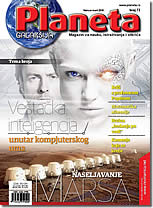 |
Godina XIII
Feb. 2016 - Mart. 2016.
|
|
| » Glavni naslovi |
SUMMARY
Summary
The Topic of this Issue
Artificial Intelligence
Dangerous robots? |
|
 |
Last year experts from Elon Musk to Stephen Hawking warned of risks that robots could pose for the economy and mankind generally. How are we to ensure that the machines be our friends, not enemies?
Since May 1997, when the IBM's computer Deep Blue won over the then chess champion Garry Kasparov in six matches, poeple are fearing a possible computer rebellion. Which job that we were sure they could not take away from us could they soon be in fact taking away? Which posts shall they take away from us and which shall they, once they do so, leave to humans?
In May 2015 Martin Ford, author of “Rise of the Robots: Technology and the Threat of the Jobless Future”, explained the concern for both office and factory workers due to the coming of the man-like : „Try to imagine a new industry, such as does not exist at present, and which could provide millions of new jobs. It is very hard.“
There is, however, an optimistic view of the same process: that the coupling of computers and robots shall free people from hard and dangerous work and shall open up room for them to use their imagination, to react among themsleves in much more personal ways, especially in the mamner that computers can not, simply because they are nto human. Where do we stand at present? |
Heritage
Association „ Milutin Milanković” |
|
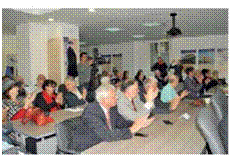 |
Milutin Milanković was a globally recognized mathematician, astronomer, climatologist, geophysicist, civil engineer, he held a Ph.D. in technical sciences from the University of Vienna, and was the pioneer of rocket engineering and a reputable professor of celestial mechanics – yet soon after his passing away (1958) his nation had forgotten him and for decades since he is not the topic of lectures to students at different departments of technical sciences, mathematics, astronomy or meteorology. And then, suddenly, at a scientific gathering, his name shone as the brightest star.
This is the mission around which the Association “Milutin Milanković” was founded in Belgrade, presently with some 300 members. The Association has since recently established its HQ in a small corner of Pop-Lukina Street, after much lack of understanding and tacit refusal to protect the work of this world class scientist from oblivion.
The Association has invested efforts to bring Milanković closer to the people across the country, organizing so far more than 30 exhibitions all over Serbia and Republic Srpska. Thanks to the Association, a boulevard in Novi Beograd is named after Milutin Milanković. Thus, along with Nikola Tesla and Mihajlo Pupin, Milanković makes up the triad of scientific giants after whom boulevards in the capital have been named.
|
Astrobiology
Where are the Aliens? |
|
 |
The Cosmos is 13.7 billion years old. Since the number of solar systems is huge and the number of galaxies in the universe exceeds one hundred billion, we can only imagine how many planets have been born and destroyed in collapsing or explosions of parent stars. In view of this huge number of planets and taking into consideration the time that it takes for an ancient civilization to be born and develop, up to now every part of Cosmos would be inhabited or at least every corner of our Galaxy visited by advanced alien emissaries from space.
Automated robotized Newman probes have the ability to self-replicate and can research the Cosmos indefinitely, even if the emissaries have long been extinct. The conclusion is therefore that by now, taking into consideration the age of our space, we should have encountered alien races far superior to ours in technological terms or we should have at least discover the counterpart of the Newman probe. This, however, has not happened. They are simply not out there. Telescopic surveying demonstrated that they are not to be found in our vicinity. Therefore it is a natural question to ask: where are they? This is the essence of the Fermi's paradox which like a ghost haunts the philosophy of astrobiology.
|
The Solar System
Inhabiting the Mars |
|
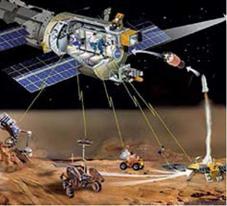 |
Much time is likely to go by before first settlements are established on Mars. Even the biggest optimist and advocate of inhabiting the neighbor planet, Elon Musk, believes that this could come to pass at the end of the next decade, provided that the development of giant rocket carriers and inter-orbital space ships proceeds according to plan and without unplanned difficulties which usually occur with such projects.
Although still far from materializing, the vision of inhabiting the Mars still has its opponents who put forward numerous varied arguments to denounce such a project. Among them is the UK scientist, mathematician and reputable expert in astronautics Robert Walker who is motivated by the concern that Mars could, by uncontrolled settlement, be permanently contaminated by microbes and substances of biological origin from the Earth. He has listed ten reasons against settlement of Mars in the near future.
|
Astronomy
Hairy Earth |
|
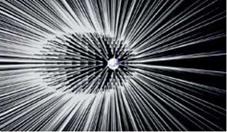 |
Scientists of the NASA Jet Propulsion Laboratory habve recently taken images of long threads of matter surrounding our planet . They named them „ Earth's Hair ”. N obody had known of this before, even the most dedicated scientists .
There is no smooth planet which from cosmic vicinity (most often from the international space station) resembles a plue-green marble .
Why would anyone be surprised by this as it has long been estimated that the invisible matter exceeds the visible matter by almost five and a half times . Leave alone dark energy whioch amounts to more than two thirds of the toal content (71 . 4 percent ). By modern devices scientists can barely record the twentieth part of it, the rest they derive indirectly !
The article in the „Astrophysical Journal ” by Ger ry Pre s o talks of the dark fibers in the Solar family . T he dark matter does not let out any light, and is therefore invisible and cannot be captured in all images . Its existence, however, is based on observations noting a strange gravitational attraction of simple matter, based on which the astronomers have measured its content, with the error of just one percent |
Aeronautics
Aircrafts of the future |
|
 |
The success of the „Solar Impulse“ projkect and the operation of aircrafts driven by engines on electric energy generated from solar cells and placed on the aircraft wings, has to some degree offered a solution and raised the question fo completely new criteria for the design of aircrafts of the future. The structure of a small aircraft such as the „Solar Impulse“ was not easy, and the structure of a modern passanger auircraft of the future, completely eco-friendly, will require the knowledge of quantum ohysics and mechanics as well as use of new materials.
Oscar Vignal, designer from Barcelona, has for years been offering interesting designs, mostly of aircrafts fo the future. After the „Sky Whale“ project, he offered its heir „Progress Eagle“ .
„Progress Eagle“ is a concept of supersonic passanger aircraft of the future with combined drive, capacity of 800 seats and distance of almost 40,000 km. To make such a trip the aircraft would use 6 engines and the drive fuel would be hydrogen at take off and landing, while during the flight it would get the necessary energy from solar cells placed on aircraft wings and from a special additional engine which used wind energy generation. Thus, the energy necessary for the flight would be generated thanks to the movement of the aircraft itself. |
MEDICINE
Aging and chronic kidney disease |
|
 |
Kidney diseases can occur at any time in a person's life, and the acute forms of kidney disease are mostly successfully treated. However, with aging, they become more frequent and turn into chronic forms. This difficult chronic kidney deficiency need not necessarily present symptoms even to the terminal phase which requires replacement of kidney function by dialysis or transplantations.
Without warning of pain, or other signs of caution, kidneys quietly lose their function and present symptoms only when it is too late to stop the irreversible process. What is more, this topic is not much talked about in public, despite the fact that mass media are more than every interested in health-related topics and on the face of it offer much advice on how to preserve health. Thanks to this, practically every person is familiar with cardiovascular disorders as the most frequent disease of the modern world, while very few are aware that kidney deficiency is very closely linked to cardio and vascular diseases and aging as their common risk factor. As many as one in ten persons, according to global statistics, has some form of kidney disease which goes unrecognized until the final stage and failure of this vital organ. This is confirmed by Professor dr Sanja Simić Ogrizović, nephrologist, consultant of the Belgrade general hospital Bel Medic.
|
Biomechanics
The body – the unknown machine |
|
| |
Biomechanics is a study of mechanical aspects of movement of the human locomotion apparatus, while motor control deals with movement control. Movement control can be studied at different levels: behavioral, mechanical or neuro-physiological. The behavioral level means that we can or cannot do something, how e do it and with what success. At the mechanical level it is about monitoring the mechanical variables describing the movement forces which are at work in the bones, joints and muscle systems. The neuro-physiological level is about the ways in which the nervous system manages movements. The human locomotion apparatus is very complex and it is still largely unknown how the nervous system manages such a complex system, obviously with great success. These are the topics presented by Professor dr Slobodan Jarić, a lecturer at a number of universities in the region.
|
Ethno-mycology
Both for fire and medicine |
|
 |
At the mention of the bee fungi many think of some honey producing fungi from which bees collect pollen or other substances and transform it into honey. However, the name is misleading as drone bee fungus is a synonym for a well known mushroom. Still, is there something that drones, the male honey bees, and fungi, specifically false tinder fungus, Fomes fomentarius, have in common?
Looking in more detail at the structure of bees and fungi and their lives, the answer is positive, and these similarities and quite big and unusual. Namely, the fungi cells are covered with the same material - chitin – which is the building material making up the wings of bees. Secondly, the tinder fungus and the drone both live parasitic lives and feed at the expense of others.
Tinder fungus is a multi-annual fungus growing from one to about ten years, which can easily be seen in the layers growing one on top of the other, resembling the tree trunk structure. Initially, the fungus has the shape of foam, enclosing whatever comes its way. After a while the foam solidifies and small twigs, leaves or other material can be found in it, or small stones, if the fungus lived on the ground. |
Geology Nature the imitator |
|
 |
There are numerous geological structures in nature of unusual appearance. Often these are confusing mixtures of solid rocks and forms resembling certain organisms, for which reason they can wrongly be classified as fossils. There are also shapes which we easily find and recognize, such as petrified puppets found in the youngest quadrant sediments in Serbia.
These are rocks created by cementing of alevritic material in steppes rich in vegetation, deposited during the pleistocene. Due to their origin they have a hollow made through the decomposition of the plant material and are therefore highly porous, enabling the circulation of surface waters and enabling carbonate matter to settle in them creating figurines of different shapes, which can be found in the regions of Slavonia, Mačva, Vojvodina, in Zemun along the Danube River and in other places where such sediments exceed dozens of meters in height. |
| |
|
Kompletni tekstove sa slikama i prilozima potražite u magazinu
"PLANETA" - štampano izdanje ili u ON LINE prodaji Elektronskog izdanja
"Novinarnica"
|
|
|
| » Pratite nas |
 |
 |
|
» Prijatelji Planete |
| » ON LINE PRODAJA |
|

6 digitalnih izdanja:
4,58 EUR/540,00 RSD
Uštedite čitajući digitalna izdanja 50%
Samo ovo izdanje:
1,22 EUR/144,00 RSD
Uštedite čitajući digitalno izdanje 20%
www.novinarnica.net
Čitajte na kompjuteru, tabletu ili mobilnom telefonu

|
| » PRELISTAJTE |
NOVINARNICA predlaže
Prelistajte besplatno
primerke
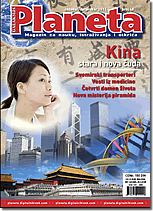
Planeta Br 48

Planeta Br 63
|
| » BROJ 72 |
 |
Godina XIII
Feb. 2016 - Mart. 2016.
|
|
|

